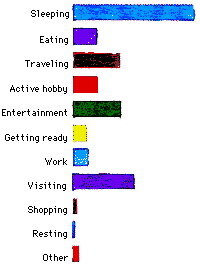| | |
The activity and work samples in this section
have been contributed by the middle years
editorial consultant, Erv Henderson, of Yorkton,
SK. The activity described below and the
examples of student work all come from his
current grade nine class. Erv is piloting the new
Saskatchewan Middle Level Mathematics
Curriculum and has adapted the following
activity from the curriculum. Rather than
working with data gathered by others and
commercially available, Erv's class decided to
conduct a personal survey of how time was
spent over a seven-day period and then display
the information in a variety of ways. The most
enjoyable part of this assignment, he reports,
was the organization and illustration of the data.
Erv stated that his class had mixed reactions to
this assignment. Most children found the
assignment unusual--as a math activity, as the
mathematics the children were working with
was all personally-derived, and it did not come
from a text. Some children who had been
successful with a previous textbook approach to
learning mathematics reported initially that they
found this activity difficult, as it required them to
think and come up with data to work with. Other
children who had not previously experienced
great success with the more traditional
approach to learning mathematics were quite
surprised that what they were doing was
mathematics and that they could be successful
learning mathematics in this way. The
assignment in general helped children
understand (1) that data management was a
valid part of mathematics, (2) that mathematics
was more than stuff from a textbook and/or drill
and practice, (3) that they could be producers of
data for mathematical activity, and (4) that they
could be successful learners and doers of
mathematics--and have fun doing it.
�What the Grade Nine Students Were Asked To
Do:
|
|

